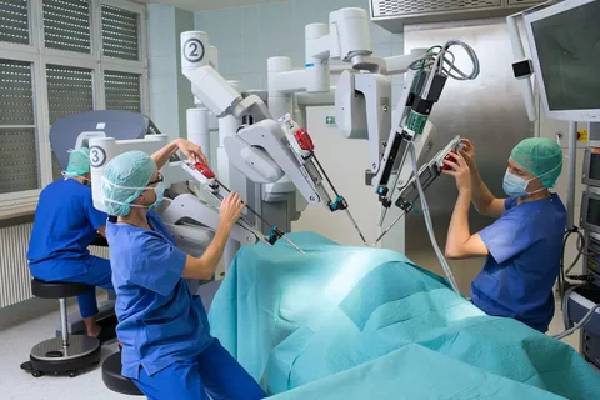Robotic Bladder Surgery: An Advanced Approach to Urological Health

Modern surgical method known as robotic bladder surgery is transforming difficult urological operations. Shorter recovery times and less complications follow from exact and minimally invasive procedures carried out by surgeons using robotic technologies. Patients needing bladder cancer surgery, cystectomy, or bladder reconstruction especially benefit from this sophisticated method.
The advantages, several techniques, operations, and recovery process connected with robotic bladder surgery will be discussed in this paper.
What is Robotic Bladder Surgery?
- Robotic bladder surgery performs delicate bladder operations using a surgical robot—most usually the da Vinci Surgical System. Using a console, the surgeon commands the robot to translate hand motions into real-time, exact actions carried out by robotic arms loaded with surgical tools. This methodology offers:
- Enhanced Precision: The robotic system offers greater dexterity and precision than traditional methods.
- Minimally Invasive Approach: Smaller incisions lead to reduced scarring and quicker recovery.
- Better Visualization: High-definition 3D cameras provide a magnified view of the surgical site, enhancing accuracy.
Types of Robotic Bladder Surgery
There are several types of robotic surgeries performed on the bladder, each tailored to address specific conditions:
- Robotic Cystectomy
- Complete or partial removal of the bladder.
- Typically performed for patients diagnosed with bladder cancer.
- Often includes reconstructive surgery to create a new urinary diversion or bladder replacement.
- Robotic Bladder Reconstruction
- Rebuilding or reshaping the bladder to restore function.
- Commonly done after tumor removal or to correct congenital defects.
- Robotic Pyeloplasty
- Surgery to relieve ureteropelvic junction obstruction.
- Involves reconstructing the part of the bladder that connects to the kidneys.
- Robotic Ureteral Reimplantation
- Surgical reattachment of the ureter to the bladder.
- Treats conditions like vesicoureteral reflux (VUR) in both adults and children.
Benefits of Robotic Bladder Surgery
Robotic bladder surgery offers several advantages over traditional open surgery and conventional laparoscopy, including:
- Reduced Pain and Discomfort
Smaller incisions mean less trauma to the body, resulting in reduced postoperative pain. - Shorter Hospital Stay
Patients typically experience a shorter hospital stay compared to open surgery. - Lower Risk of Complications
The robotic approach minimizes the risk of infection and postoperative complications. - Faster Recovery and Return to Activities
Patients often return to normal activities sooner, leading to an improved quality of life. - Improved Surgical Outcomes
Studies show that robotic bladder surgeries result in better overall outcomes, including lower recurrence rates for cancer patients.
The Robotic Bladder Surgery Procedure
The robotic bladder surgery process involves several key steps:
- Preoperative Preparation
- Patients undergo imaging tests, blood work, and a comprehensive health evaluation.
- Fasting is required before surgery to ensure a clear operating field.
- Surgical Procedure
- The patient is placed under general anesthesia.
- Small incisions are made in the abdomen to insert the robotic arms and instruments.
- The surgeon performs the procedure using a console, controlling the robotic arms with precision.
- For complex surgeries like cystectomy, lymph nodes may also be removed.
- Postoperative Care
- Patients are closely monitored in the hospital for 1-3 days, depending on the surgery’s complexity.
- A catheter is typically placed for bladder drainage and removed after a few days.
- Pain management and infection prevention are key focuses of postoperative care.
Who is a Candidate for Robotic Bladder Surgery?
Robotic bladder surgery is suitable for patients with various bladder conditions, including:
- Bladder Cancer
- Severe Urinary Incontinence
- Congenital Bladder Abnormalities
- Ureteral Obstructions
However, not every patient is a candidate. Surgeons consider factors like overall health, stage of disease, and previous surgeries to determine eligibility.
Recovery and Aftercare Tips
The recovery process for robotic bladder surgery is typically smoother than traditional methods. To optimize recovery:
- Follow a Healthy DietMaintain a balanced diet rich in protein and vitamins to promote healing.
- Avoid Strenuous ActivitiesRefrain from lifting heavy objects or engaging in intense physical activity for the first few weeks.
- Stay HydratedAdequate hydration helps prevent urinary complications.
- Attend Follow-Up AppointmentsRegular check-ups are essential to monitor healing and address any concerns.
Risks and Complications
While robotic bladder surgery is generally safe, potential risks include:
- Infection at the Surgical Site
- Bleeding
- Urinary Leakage or Incontinence
- Injury to Surrounding Organs
Discuss these risks with your surgeon to make an informed decision.
Conclusion
Offering exact, minimally invasive treatment options with enhanced outcomes for many patients, robotic bladder surgery marks a major advance in urological surgery. See a skilled urologic oncologist to discuss the advantages and alternatives of robotic surgery whether you or a loved one are thinking about bladder surgery.
Patients who choose robotic bladder surgery ensure a better road to restored health by gaining access to state-of-the-art equipment that stresses safety, efficiency, and faster recovery.





